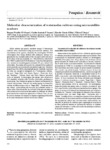Use este identificador para citar ou linkar para este item:
http://www.alice.cnptia.embrapa.br/alice/handle/doc/974131Registro completo de metadados
| Campo DC | Valor | Idioma |
|---|---|---|
| dc.contributor.author | GAMA, R. N. C. S. | pt_BR |
| dc.contributor.author | SANTOS, C. A. F. | pt_BR |
| dc.contributor.author | DIAS, R. de C. S. | pt_BR |
| dc.contributor.author | SOUZA, F. de F. | pt_BR |
| dc.date.accessioned | 2013-12-17T11:11:11Z | pt_BR |
| dc.date.available | 2013-12-17T11:11:11Z | pt_BR |
| dc.date.created | 2013-12-17 | pt_BR |
| dc.date.issued | 2013 | pt_BR |
| dc.identifier.citation | Horticultura Brasileira, v. 31, n. 4, p. 522-527, out./dez. 2013. | pt_BR |
| dc.identifier.uri | http://www.alice.cnptia.embrapa.br/alice/handle/doc/974131 | pt_BR |
| dc.description | Allelic patterns and genetic similarity among 17 watermelon cultivars were established using microsatellite markers. For visualization of the genetic similarity, the dendrogram UPGMA (Unweighted Pair Group Method with Arithmetic Means) was generated by the similarity matrix of the Jacquard coefficient, based on 34 alleles of ten microsatellite loci. Total DNA was extracted by the CTAB 2x method and PCR (Polymerase Chain Reaction) products were analyzed in denaturing polyacrylamide 6% gels, stained with silver nitrate. The number of base pairs was estimated by the method of inverse mobility, based on known size product regression. Similarity ranged from 34 to 100%, reflecting high genetic variability. Analyzed loci were not enough to distinguish all 17 watermelon cultivars. The pairs ?Sugar Baby? and ?Omaru Yamato?, ?Charleston Gray? and ?Sunshade?, ?Crimson Sweet? and ?Nova Crimson? presented 100% of similarity. In dendrogram two groups were observed at 0.42 similarity cut point, with Citrullus colocynthis, positioned as an out group. One watermelon group was formed predominantly by cultivars derived from ?Crimson? and another group was formed by cultivars of different types such as ?Sugar Baby?, ?Charleston Gray? and ?Pérola?. Allele pattern and base pair (bp) estimates for the 34 alleles in the 10 microsatellite loci revealed in the present study are a first endeavor to use microsatellite markers in situations of cultivar protection for the watermelon agribusiness in Brazil. They can also be used in situations of commercial disputes regarding certification of the main watermelon cultivars used in the country. | pt_BR |
| dc.language.iso | eng | eng |
| dc.rights | openAccess | eng |
| dc.subject | Divergência genética | pt_BR |
| dc.subject | Marcadores microssatélites | pt_BR |
| dc.subject | Melhoramento genético | pt_BR |
| dc.subject | Watermelon | pt_BR |
| dc.title | Molecular characterization of watermelon cultivars using microsatellite markers. | pt_BR |
| dc.type | Artigo de periódico | pt_BR |
| dc.date.updated | 2013-12-17T11:11:11Z | pt_BR |
| dc.subject.thesagro | Melancia | pt_BR |
| dc.subject.thesagro | Citrullus Lanatus | pt_BR |
| dc.subject.nalthesaurus | Breeding | pt_BR |
| riaa.ainfo.id | 974131 | pt_BR |
| riaa.ainfo.lastupdate | 2013-12-17 | pt_BR |
| dc.contributor.institution | RENATA NATÁLIA C. S. GAMA, UNIVERSIDADE ESTADUAL DE FEIRA DE SANTANA | pt_BR |
| dc.contributor.institution | CARLOS ANTONIO FERNANDES SANTOS, CPATSA | eng |
| dc.contributor.institution | RITA DE CASSIA SOUZA DIAS, CPATSA | eng |
| dc.contributor.institution | FLAVIO DE FRANCA SOUZA, CPATSA. | eng |
| Aparece nas coleções: | Artigo em periódico indexado (CPATSA)  | |
Arquivos associados a este item:
| Arquivo | Descrição | Tamanho | Formato | |
|---|---|---|---|---|
| Carlos3.pdf | 326,43 kB | Adobe PDF |  Visualizar/Abrir |









